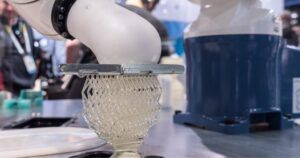Prototypes are a key element in industrial design and production. They are essential for testing both the aesthetics and functionality of a product. And they help determine the success or failure of an innovative strategy.
Thanks to these models we can turn a simple idea into a tangible and functional proposal; check its features, such as ergonomics, aesthetics and geometry, and at the same time detect errors, shortcomings, defects, etc., without compromising production. Prototypes are basic tools for a company’s sales and marketing departments, for attending trade fairs and events, and for producing short series.
All these benefits make the prototyping phase a very valuable step in the production process, which should be carried out before starting the production of moulds and tooling in order to minimize the risk of failed investments. There are two basic technologies for prototyping, and a third, more specific one.
Additive manufacturing
It is a 3D printing in which a nozzle/laser/lamp provides the material to capture the computer image of a part. This type of manufacturing has 4 techniques:
- SLA (stereolithography). This technology uses a liquid resin that solidifies with the action of a laser and makes it possible to create high-precision parts, its main advantage. However, it is an expensive technique that requires post-processing of the part and careful handling due to the fragility of the prototypes. By using biocompatible materials, this technique is used to create models of medical parts or dental implants.
- SLS (sintered polyamide sintering). SLS uses a laser beam to sinter or compact powder, plastic or metal materials to create the prototype. Although this is an inexpensive technology that reproduces the part optimally, it provides less precision and a rougher finish because of the materials used.
- Multijet fusion (MJF). This technology uses lamps instead of lasers, offers the best mechanical performance and is very useful for both prototypes and short printed series.
- FDM (Fused deposition modeling). FDM works by heating a wire that is deposited layer by layer to reproduce the 3D model. It is very versatile because it can use a multitude of materials and offers very good mechanical properties. However, the finishes it offers are not very fine and it is expensive.
Machining
This technique consists of sculpting a block of plastic or metallic material with CNC machines, milling machines, lathes, etc. …… In this way, the raw material is transformed into a specific part by eliminating the excess material in a controlled manner. The main advantage is that parts are obtained in
definitive material.
Silicone moulds
Actually, this technique is not a technology itself: it is used to make pre-series, i.e. several units of the same model.
To do this, a silicone mold is made from a prototype into which materials such as polyurethane, wax or resin are poured. When the material solidifies, it creates an exact replica of the prototype used as a model to make the mold. These molds are very useful for simulating thermoplastics; however, the resulting parts must undergo a subsequent polishing process to give them a proper finish.
Prototyping is a fundamental phase in the process developed by IDELT in the manufacture of high value-added plastic parts. The Basque company studies which technique is the most appropriate for making a specific prototype depending on the characteristics and requirements of the component and accompanies and advises its customers throughout the whole process.
The result is a unitary piece that showcases IDELT’s capabilities and brings together all the aesthetic, functional and regulatory requirements of the component.
“The realization of a prototype is not only important to present a product at a trade fair or to offer an indication of what its physical appearance will be, but it is also crucial to obtain the necessary certifications in critical areas such as the medical sector and, of course, to verify that the product meets the expectations and functionalities required by the customer,” explains Iñigo Yaniz, head of prototyping at Idelt.










